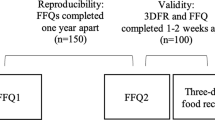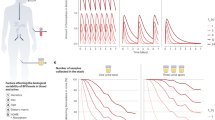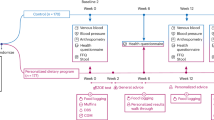Abstract
Background/Objectives:
The validity of dietary assessment in large-scale cohort studies has been questioned. Combining data sources for the estimation of usual intake in a blended approach may enhance the validity of dietary measurement. Our objective was to develop a web-based 24-h food list for Germany to identify foods consumed during the previous 24 h and to evaluate the performance of the new questionnaire in a feasibility study.
Subjects/Methods:
Available data from the German National Nutrition Survey II were used to develop a finite list of food items. A total of 508 individuals were invited to fill in the 24-h food list via the Internet up to three times during a 3–6-month time period. In addition, participants were asked to evaluate the questionnaire using a brief online evaluation form.
Results:
In total, 246 food items were identified for the 24-h food list, reflecting >75% variation in intake of 27 nutrients and four major food groups. Among the individuals invited, 64% participated in the feasibility study. Of these, 100%, 85% and 68% of participants completed the 24-h food list one, two or three times, respectively. The average time needed to complete the questionnaire was 9 min, and its acceptability by participants was rated as high.
Conclusions:
The 24-h food list represents a promising new dietary assessment tool that can be used as part of a blended approach combining multiple data sources for valid estimation of usual dietary intake in large-scale cohort studies.
This is a preview of subscription content, access via your institution
Access options
Subscribe to this journal
Receive 12 print issues and online access
$259.00 per year
only $21.58 per issue
Buy this article
- Purchase on SpringerLink
- Instant access to full article PDF
Prices may be subject to local taxes which are calculated during checkout

Similar content being viewed by others
References
Rosner B, Willett WC, Spiegelman D . Correction of logistic regression relative risk estimates and confidence intervals for systematic within-person measurement error. Stat Med 1989; 8: 1051–1069. discussion 1071–1073.
Willett WC, Hu FB . Not the time to abandon the food frequency questionnaire: point. Cancer Epidemiol Biomarkers Prev 2006; 15: 1757–1758.
Kristal AR, Potter JD . Not the time to abandon the food frequency questionnaire: counterpoint. Cancer Epidemiol Biomarkers Prev 2006; 15: 1759–1760.
Kipnis V, Midthune D, Buckman DW, Dodd KW, Guenther PM, Krebs-Smith SM et al. Modeling data with excess zeros and measurement error: application to evaluating relationships between episodically consumed foods and health outcomes. Biometrics 2009; 65: 1003–1010.
Tooze JA, Midthune D, Dodd KW, Freedman LS, Krebs-Smith SM, Subar AF et al. A new statistical method for estimating the usual intake of episodically consumed foods with application to their distribution. J Am Diet Assoc 2006; 106: 1575–1587.
Dodd KW, Guenther PM, Freedman LS, Subar AF, Kipnis V, Midthune D et al. Statistical methods for estimating usual intake of nutrients and foods: a review of the theory. J Am Diet Assoc 2006; 106: 1640–1650.
Tooze JA, Kipnis V, Buckman DW, Carroll RJ, Freedman LS, Guenther PM et al. A mixed-effects model approach for estimating the distribution of usual intake of nutrients: the NCI method. Stat Med 2010; 29: 2857–2868.
Illner AK, Nothlings U, Wagner K, Ward H, Boeing H . The assessment of individual usual food intake in large-scale prospective studies. Ann Nutr Metab 2010; 56: 99–105.
de Boer EJ, Slimani N, van 't Veer P, Boeing H, Feinberg M, Leclercq C et al. The European Food Consumption Validation Project: conclusions and recommendations. Eur J Clin Nutr 2011; 65 (Suppl 1), S102–S107.
Haubrock J, Nothlings U, Volatier JL, Dekkers A, Ocke M, Harttig U et al. Estimating usual food intake distributions by using the multiple source method in the EPIC-Potsdam Calibration Study. J Nutr 2011; 141: 914–920.
Souverein OW, Dekkers AL, Geelen A, Haubrock J, de Vries JH, Ocke MC et al. Comparing four methods to estimate usual intake distributions. Eur J Clin Nutr 2011; 65 (Suppl 1), S92–S101.
Subar AF, Dodd KW, Guenther PM, Kipnis V, Midthune D, McDowell M et al. The food propensity questionnaire: concept, development, and validation for use as a covariate in a model to estimate usual food intake. J Am Diet Assoc 2006; 106: 1556–1563.
Carroll RJ, Midthune D, Subar AF, Shumakovich M, Freedman LS, Thompson FE et al. Taking advantage of the strengths of 2 different dietary assessment instruments to improve intake estimates for nutritional epidemiology. Am J Epidemiol 2012; 175: 340–347.
Schatzkin A, Subar AF, Moore S, Park Y, Potischman N, Thompson FE et al. Observational epidemiologic studies of nutrition and cancer: the next generation (with better observation). Cancer Epidemiol Biomarkers Prev 2009; 18: 1026–1032.
Arab L, Wesseling-Perry K, Jardack P, Henry J, Winter A . Eight self-administered 24-hour dietary recalls using the Internet are feasible in African Americans and Whites: the energetics study. J Am Diet Assoc 2010; 110: 857–864.
Subar AF, Kirkpatrick SI, Mittl B, Zimmerman TP, Thompson FE, Bingley C et al. The automated self-administered 24-hour dietary recall (ASA24): a resource for researchers, clinicians, and educators from the National Cancer Institute. J Acad Nutr Diet 2012; 112: 1134–1137.
Apovian CM, Murphy MC, Cullum-Dugan D, Lin PH, Gilbert KM, Coffman G et al. Validation of a web-based dietary questionnaire designed for the DASH (dietary approaches to stop hypertension) diet: the DASH online questionnaire. Public Health Nutr 2010; 13: 615–622.
Liu B, Young H, Crowe FL, Benson VS, Spencer EA, Key TJ et al. Development and evaluation of the Oxford WebQ, a low-cost, web-based method for assessment of previous 24 h dietary intakes in large-scale prospective studies. Public Health Nutr 2011; 14: 1998–2005.
Noethlings U, Hoffmann K, Bergmann MM, Boeing H . Portion size adds limited information on variance in food intake of participants in the EPIC-Potsdam study. J Nutr 2003; 133: 510–515.
Max Rubner-Institut. Nationale Verzehrsstudie II, Ergebnisbericht Teil 1 [in German: National Nutrition Survey II, first report]. Max Rubner-Institut, Federal Research Institute of Nutrition and Food. Karlsruhe. 2008 [cited 11 December 2012]; Available from http://www.mri.bund.de/fileadmin/Institute/EV/NVS_II_Abschlussbericht_Teil_1_mit_Ergaenzungsbericht.pdf.
Slimani N, Deharveng G, Charrondiere RU, van Kappel AL, Ocke MC, Welch A et al. Structure of the standardized computerized 24-h diet recall interview used as reference method in the 22 centers participating in the EPIC project. European Prospective Investigation into Cancer and Nutrition. Comput Methods Programs Biomed 1999; 58: 251–266.
Max Rubner-Institut (Federal Research Institute of Nutrition and Food). German Nutrient Database - Bundeslebensmittelschlüssel (BLS) Version 3.01. 2010 [cited 11 December 2012]; Available from http://www.blsdb.de.
Willett W . Nutritional Epidemiology. Oxford University Press: New York, NY, USA, 1998.
Willett WC, Sampson L, Stampfer MJ, Rosner B, Bain C, Witschi J et al. Reproducibility and validity of a semiquantitative food frequency questionnaire. Am J Epidemiol 1985; 122: 51–65.
Block G, Hartman AM, Dresser CM, Carroll MD, Gannon J, Gardner L . A data-based approach to diet questionnaire design and testing. Am J Epidemiol 1986; 124: 453–469.
Nothlings U, Hoffmann K, Bergmann MM, Boeing H . Fitting portion sizes in a self-administered food frequency questionnaire. J Nutr 2007; 137: 2781–2786.
Khanna N, Boushey CJ, Kerr D, Okos M, Ebert DS, Delp EJ . An overview of The Technology Assisted Dietary Assessment Project at Purdue University. ISM 2010; 290–295.
Zimmerman TP, Hull SG, McNutt S, Mittl B, Islam N, Guenther PM et al. Challenges in converting an interviewer-administered food probe database to self-administration in the National Cancer Institute Automated Self-administered 24-Hour Recall (ASA24). J Food Compost Anal 2009; 22 (Supplement 1), S48–S51.
Waijers PM, Dekkers AL, Boer JM, Boshuizen HC, van Rossum CT . The potential of AGE MODE, an age-dependent model, to estimate usual intakes and prevalences of inadequate intakes in a population. J Nutr 2006; 136: 2916–2920.
Thomas DG, Mark SD . Max_r: an optimal method for the selection of subsets of foods for the measurement of specific nutrient exposures. Comput Methods Programs Biomed 1997; 54: 151–156.
Mark SD, Thomas DG, Decarli A . Measurement of exposure to nutrients: an approach to the selection of informative foods. Am J Epidemiol 1996; 143: 514–521.
Smith B, Smith TC, Gray GC, Ryan MA . When epidemiology meets the Internet: web-based surveys in the Millennium Cohort Study. Am J Epidemiol 2007; 166: 1345–1354.
Statistisches Bundesamt. [data-base on the Internet] 2012 [cited 21 November 2012]; Available from https://www.destatis.de/DE/ZahlenFakten/GesellschaftStaat/EinkommenKonsumLebensbedingungen/ITNutzung/Tabellen/ZeitvergleichComputernutzung_IKT.html.
Acknowledgements
This project was conducted in the context of the pretest studies of the German National Cohort (www.nationale-kohorte.de). These were funded by the Federal Ministry of Education and Research (BMBF), Grant no. 01ER1001A-I, and supported by the Helmholtz Association as well as the participating universities and Institutes of the Leibniz Association.
Author information
Authors and Affiliations
Corresponding author
Ethics declarations
Competing interests
The authors declare no conflicts of interest.
Rights and permissions
About this article
Cite this article
Freese, J., Feller, S., Harttig, U. et al. Development and evaluation of a short 24-h food list as part of a blended dietary assessment strategy in large-scale cohort studies. Eur J Clin Nutr 68, 324–329 (2014). https://doi.org/10.1038/ejcn.2013.274
Received:
Revised:
Accepted:
Published:
Issue Date:
DOI: https://doi.org/10.1038/ejcn.2013.274



